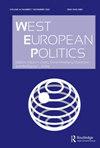The formalisation of minority governments
IF 3.6
1区 社会学
Q1 POLITICAL SCIENCE
引用次数: 2
Abstract
Abstract The vast majority of elections in parliamentary systems result in minority situations. During cabinet formation, parties have three options: building a winning coalition, a genuine substantive minority cabinet without support, or a formal minority with institutionalised long-term support partnerships. Even though the use of permanent support partners has increased substantially, there is still comparatively little knowledge about the circumstances under which parties choose to enter such formalised support partnerships instead of winning coalitions. This article aims to close this gap by analysing how the party system, the institutional configuration, as well as the bargaining environment influence which cabinet type forms. The dataset includes 469 cabinets from 27 Eastern and Western European countries between 1970 and 2019. The hypotheses are tested with the help of multinomial model estimations. While only few of the traditional explanations can explain the formation of formal minority cabinets, the results show that there is a time-trend towards more formalisation.少数民族政府的形式化
本文章由计算机程序翻译,如有差异,请以英文原文为准。
求助全文
约1分钟内获得全文
求助全文
来源期刊

West European Politics
POLITICAL SCIENCE-
CiteScore
10.00
自引率
7.10%
发文量
58
期刊介绍:
West European Politics (WEP)has established itself as one of the most authoritative journals covering political and social issues in Western Europe. It has a substantial reviews section and coverage of all national elections in Western Europe. Its comprehensive scope, embracing all the major political and social developments in all West European countries, including the European Union, makes it essential reading for both political practitioners and academics.
 求助内容:
求助内容: 应助结果提醒方式:
应助结果提醒方式:


